A Study on the Mechanical Mechanism of Injection Heat to Increase Production of Gas in Low-Permeability Coal Seam
Abstract
:1. Introduction
2. Coal and Rock Damage-Heat-Gas-Solid Multi-Field Coupling Theory
2.1. Damage and Deformation Control Equation of Coal and Rock Mass
2.2. Effective Stress Theory of Coal Containing Gas
2.3. Damage and Deformation Control Equation of Coal Containing Gas
2.4. Migration Theory of Gas in Coal Seam
2.4.1. Gas Content Equation in Coal Seam
2.4.2. Control Equation of Gas Migration
Fick Diffusion Equation
Knudsen Diffusion Equation
Nonlinear Seepage Equation
2.4.3. Continuity Equation of Gas Migration in Coal Seam
2.5. Control Equation of Temperature Field of the Coal Containing Gas
2.6. Evolution Mechanism of Permeability of Damaged Coal Mass
2.7. Heat-Gas-Solid Coupling Model of Damaged Coal Seam
3. Numerical Solution of Damage-Heat-Gas-Solid Coupling Model of Coal and Rock Mass
3.1. Finite Element Equation for Calculating the Damage and Deformation of Coal and Rock
3.1.1. Calculation of Equivalent Nodal Load
3.1.2. Calculation of Damage Stiffness Matrix of Coal and Rock
3.2. Finite Element Equation of Temperature Field of Coal Containing Gas
The Finite Element Equation of the Transient Temperature Field
3.3. Finite Element Equation of Gas Seepage
4. Numerical Simulation of Gas Drainage by Borehole Injection Heat
4.1. Numerical Model
4.2. Effect of Heat Injection Temperature on Gas Production Efficiency
4.3. The Influence of Injection Heat Temperature on the Distribution of Gas Pressure
4.4. Effects of theThermal Expansion Coefficient on Gas Production
5. Conclusions
- (1)
- When considering the effects of the temperature, the gas migration and the redistribution of mining stress comprehensively, this paper proposes using the effective strain field to define the damage field of the coal body. This variable is a quantitative description for the degree of coal rupture and damage. A new mathematical model of coal damage-heat-gas-solid multi-field coupling is developed.
- (2)
- Based on the multi-physical field coupling theory that was established in this paper, according to the numerical solution method, the finite element source program is developed twice by using FORTRAN language, and the multi-field coupling analysis program is compiled when considering temperature, gas seepage, damage, and deformation of coal and rock. Subsequently, it was applied for the analysis of borehole thermal stimulation for coal-bed methane mining. The results show that, when the injection heat temperature increased from 350 K to 400 K, the rate of gas production and total gas production increased by more than 110% and 90%, respectively. As gas drainage is carried out, the efficiency of gas production is gradually increased. When the drainage time changed from 30 d to 90 d, the total gas production increased from 90% to 110%, and the amount of gas production significantly increased.
- (3)
- The thermal stimulation of boreholes caused the rise of coal seam temperature, which promoted the decrease of gas pressure and the increase of the effective extraction radius of boreholes. For example, when the gas is extracted for 60 days, the effective extraction radius without heat injection is 1.31 m. When the injection temperatures are 350 K, 375 K, and 400 K, the effective extraction radius are 1.38 m, 1.395 m, and 1.41 m, respectively. The thermal expansion coefficient of coal seam has significant effect on the gas production rate of coal-bed methane. The main reason is that the thermal expansion coefficient changes the effective stress of coal body and the inward thermal expansion deformation of coal pores. The former factor makes the permeability of coal seam increase first and then decrease, while the latter makes the permeability of coal seam decrease first and then increase, resulting in the trend that the gas production rate first decreases and then increases.
- (4)
- In this paper, the effect of coal fracture and damage on the deformation of solid structure and gas migration is investigated, and the paper has made great progress when compared with previous studies. This paper utilizes the damage variable to describe the development of coal fracture since the finite element theory adopted is based on the continuous mechanics. Whereas, the development and expansion of multiple fractures of coal body under the action of multiple physical fields cannot be accurately studied. To simplify the mechanical model, the gas-liquid two-phase flow that occurred during the heat injection process has not been considered, which poses a great challenge to our future work.
Author Contributions
Funding
Acknowledgments
Conflicts of Interest
References
- Kang, J.; Zhou, F.; Qiang, Z.; Zhu, S. Evaluation of gas drainage and coal permeability improvement with liquid CO2 gasification blasting. Adv. Mech. Eng. 2018, 10. [Google Scholar] [CrossRef]
- Puri, R.; Yee, D. Enhanced Coalbed Methane Recovery. Soc. Pet. Eng. AIME 1990, 65, 193–202. [Google Scholar]
- Syed, A.; Shi, J.Q.; Durucan, S. Permeability and injectivity improvement in CO2 enhanced coalbed methane recovery: Thermal stimulation of the near wellbore region. Energy Procedia 2011, 4, 2137–2143. [Google Scholar] [CrossRef]
- Cai, Y.D.; Liu, D.M.; Liu, Z.H.; Zhou, Y.F.; Che, Y. Evolution of pore structure, submaceral composition and produced gases of two Chinese coals during thermal treatment. Fuel Process. Technol. 2016, 156, 298–309. [Google Scholar] [CrossRef]
- Yang, R.T.; Saunders, J.T. Adsorption of gases on coals and heat treated coals at elevated temperature and pressure: 1. Adsorption from hydrogen and methane as single gases. Fuel 1985, 64, 616–620. [Google Scholar] [CrossRef]
- Lin, Y.B.; Ma, D.M.; Liu, Y.H. Experiment of the influence of temperature on coalbed methane adsorption. Coal Geol. Explor. 2012, 40, 24–28. [Google Scholar]
- Zhou, S.N.; Lin, B.Q. Coal Seam Gas Occurrence and Flow Theory; China Coal Industry Press: Beijing, China, 1999. [Google Scholar]
- Salmachi, A.; Haghighi, M. Feasibility study of thermally enhanced gas recovery of coal seam gas reservoirs using geothermal resources. Energy Fuels 2012, 26, 5048–5059. [Google Scholar] [CrossRef]
- Cheraghian, G. A new thermal method concept for IOR from oil reservoir using optimized in-situ combustion. In Proceedings of the 78th EAGE Conference and Exhibition, Vienna, Austria, 30 May–2 June 2016. [Google Scholar]
- Wang, H.Y.; Ajao, O.; Economides, M.J. Conceptual study of thermal stimulation in shale gas formations. J. Nat. Gas Sci. Eng. 2014, 21, 874–885. [Google Scholar] [CrossRef]
- Wong, T.F.; Brace, W.F. Thermal expansion of rocks: Some measurements at high pressure. Tectonophysics 1979, 57, 95–117. [Google Scholar] [CrossRef]
- Akbarzadeh, H.; Chalaturnyk, R.J. Structural changes in coal at elevated temperature pertinent to underground coal gasification: A review. Int. J. Coal Geol. 2014, 131, 126–146. [Google Scholar] [CrossRef]
- Zhu, W.C.; Wei, C.H.; Liu, J.; Qu, H.Y.; Elsworth, D. A model of coal-gas interaction under variable temperatures. Int. J. Coal Geol. 2011, 86, 213–221. [Google Scholar] [CrossRef]
- Li, Z.Q.; Xian, X.F.; Long, Q.M. Experiment study of coal permeability under different temperature and stress. J. China Univ. Min. Technol. 2009, 38, 523–527. [Google Scholar]
- Wang, S.; Zhou, F.; Kang, J.; Wang, X.; Li, H.; Wang, J. A heat transfer model of high-temperature nitrogen injection into a methane drainage borehole. J. Nat. Gas Sci. Eng. 2015, 24, 449–456. [Google Scholar] [CrossRef]
- Shahtalebi, A.; Khan, C.; Dmyterko, A.; Shukla, P.; Rudolph, V. Investigation of thermal stimulation of coal seam gas fields for accelerated gas recovery. Fuel 2016, 180, 301–313. [Google Scholar] [CrossRef]
- Qian, J.; Zhou, J. Two damage models of concrete and its application. J. Hohai Univ. 1989, 3, 40–47. [Google Scholar]
- Mazars, J.; Boerman, D.J.; Piatti, G. Mechanical damage and fracture of concrete structure. In Proceedings of the 5th International Conference on Fracture (ICF5), Cannes, France, 29 March–3 April 1981. [Google Scholar]
- Wu, G.; Sun, J.; Wu, Z. Damage mechanical analysis of unloading failure of intact rock mass under complex stress state. J. Hohai Univ. 1997, 25, 46–51. [Google Scholar]
- Wu, S.Y.; Guo, Y.Y. Study on the movement property of coal seam methane. J. China Coal Soc. 1999, 24, 65–69. [Google Scholar]
- Wu, Y.; Liu, J.; Chen, Z.; Elsworth, D.; Pone, D. A dual poroelastic model for CO2-enhanced coalbed methane recovery. Int. J. Coal Geol. 2011, 86, 177–189. [Google Scholar] [CrossRef]
- Zhang, H.; Liu, J.; Elsworth, D. How sorption-induced matrix deformation affects gas flow in coal seams: A new FE model. Int. J. Rock Mech. Min. Sci. 2008, 45, 1226–1236. [Google Scholar] [CrossRef]
- Carman, P.C. Flow of Gases through Porous Media; Academic Press: New York, NY, USA, 1956. [Google Scholar]
- Ye, Z.; Chen, D.; Wang, J.G. Evaluation of the non-Darcy effect in coalbed methane production. Fuel 2014, 121, 1–10. [Google Scholar] [CrossRef]
- Cai, J.C. A fractal approach to low velocity non-Darcy flow in a low permeability porous medium. Chin. Phys. B 2014, 24, 385–389. [Google Scholar] [CrossRef]
- Nie, B.S.; He, X.Q.; Wang, E.Y. The diffusion mechanism and model of gas in coal seam. China Saf. Sci. J. 2000, 10, 24–28. [Google Scholar]
- Peter Luo, Y. Methane Emission from Coal Mine; China Coal Industry Publishing House: Beijing, China, 1983. [Google Scholar]
- Roy, S.; Raju, R.; Chuang, H.F.; Cruden, B.A.; Meyyappan, M. Modeling gas flow through micro channels and nanopores. J. Appl. Phys. 2003, 93, 4870–4879. [Google Scholar] [CrossRef]
- Jones, F.O.; Owens, W.W. A laboratory study of low-permeability gas sands. J. Pet. Technol. 1980, 32, 1631–1640. [Google Scholar] [CrossRef]
- Chen, X.Z.; Zhang, L.P. Numerical analysis for the influence of temperature field on coalbed methane migration by gas injection. J. Min. Saf. Eng. 2014, 31, 803–808. [Google Scholar]
- Teng, T. Mechanism of Heat-Moisture-Fluid-Solid Interactions in Coal Seam Gas Recovery. Ph.D. Thesis, China University of Mining and Technology, Xuzhou, China, 2017. [Google Scholar]
- Dai, Y.; Chen, W.; Wu, G.; Zhou, X. Study on elastoplastic damage model of unsaturated rock mass and its application. J. Rock Mech. Eng. 2008, 4, 728–735. [Google Scholar]
- Yu, T.; Lu, P.; Sun, J.; Deng, Z. Measurement of effective drainage radius based on gas flow and pressure of boreholes. J. Min. Saf. Eng. 2012, 4, 596–600. [Google Scholar]

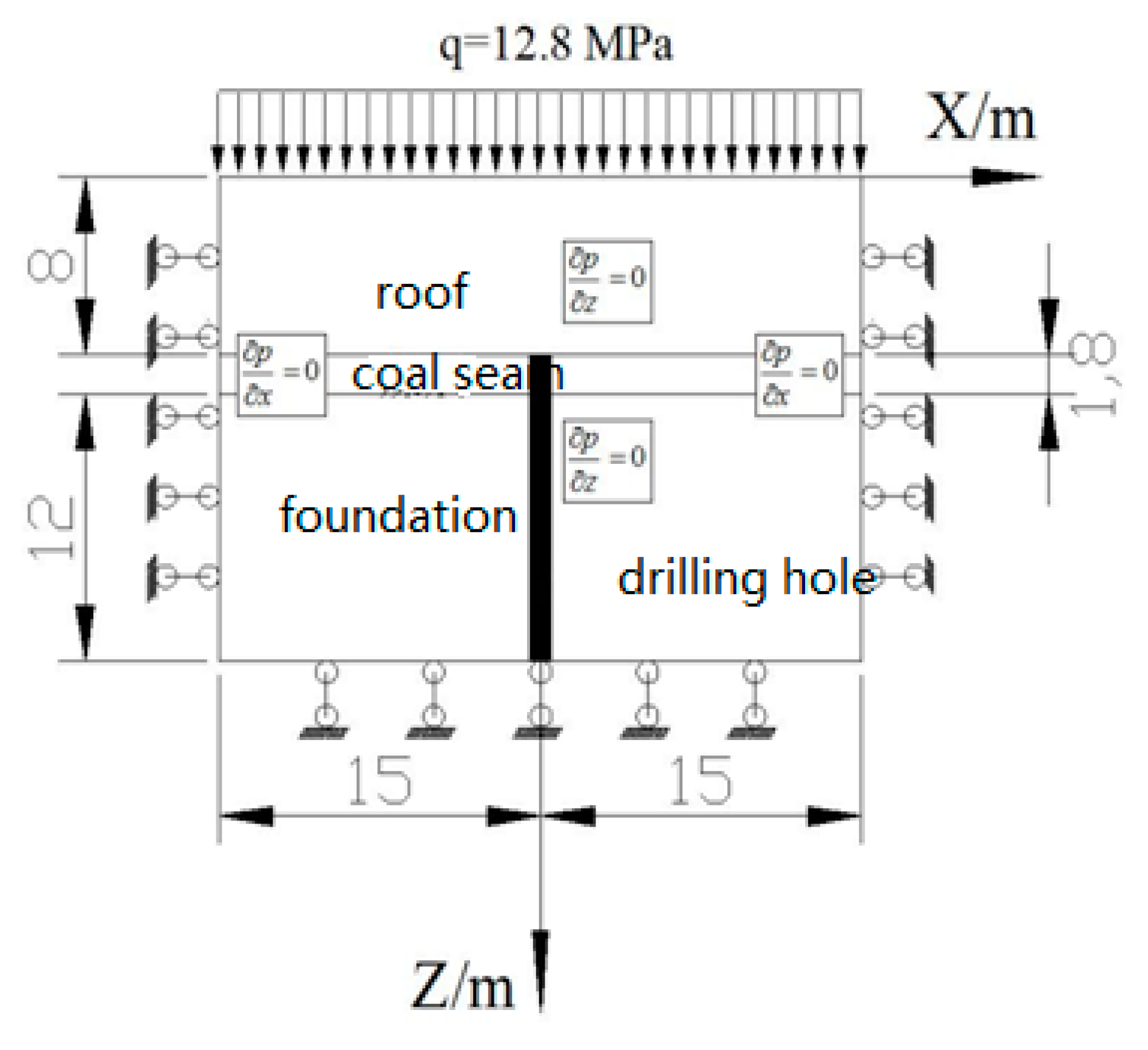
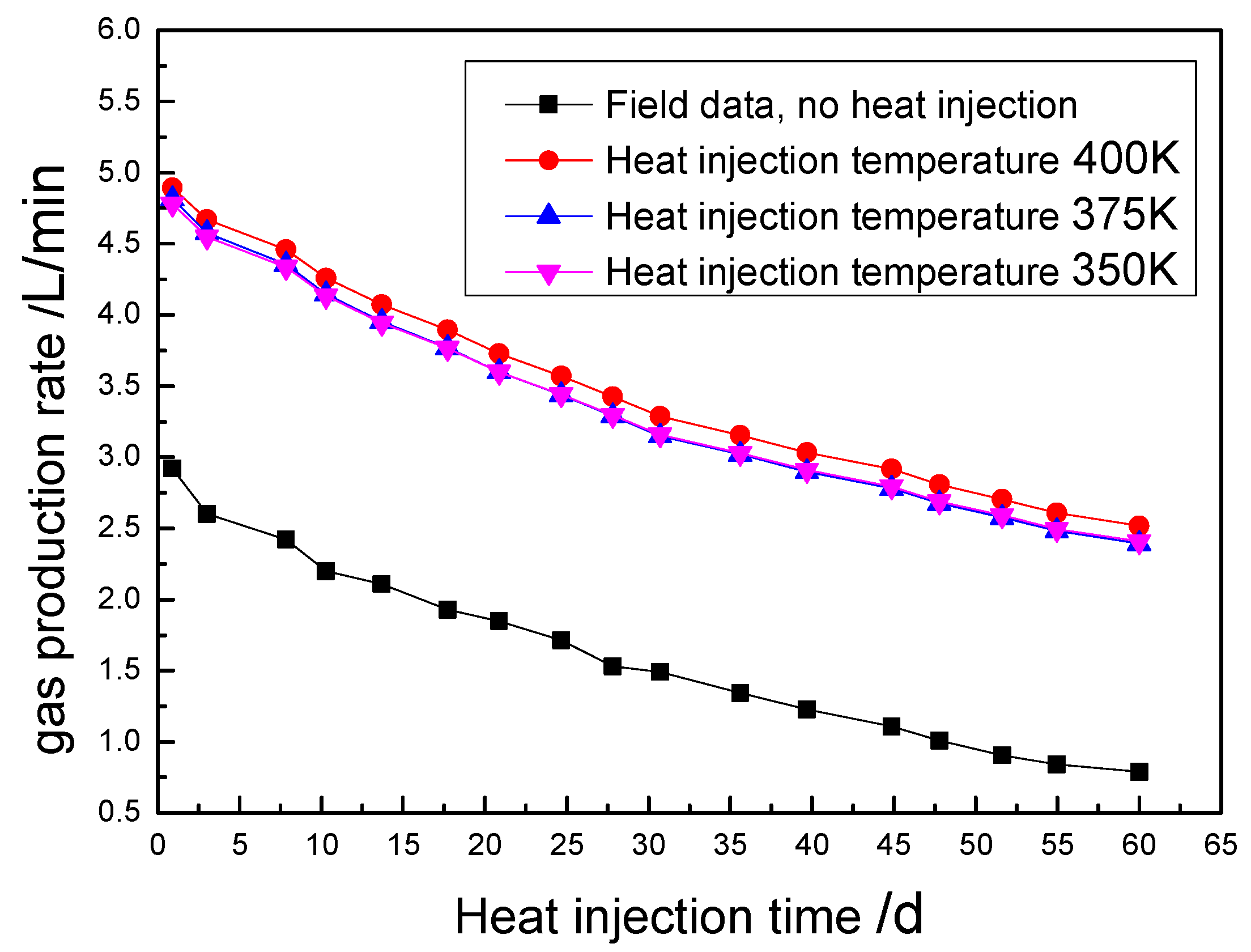

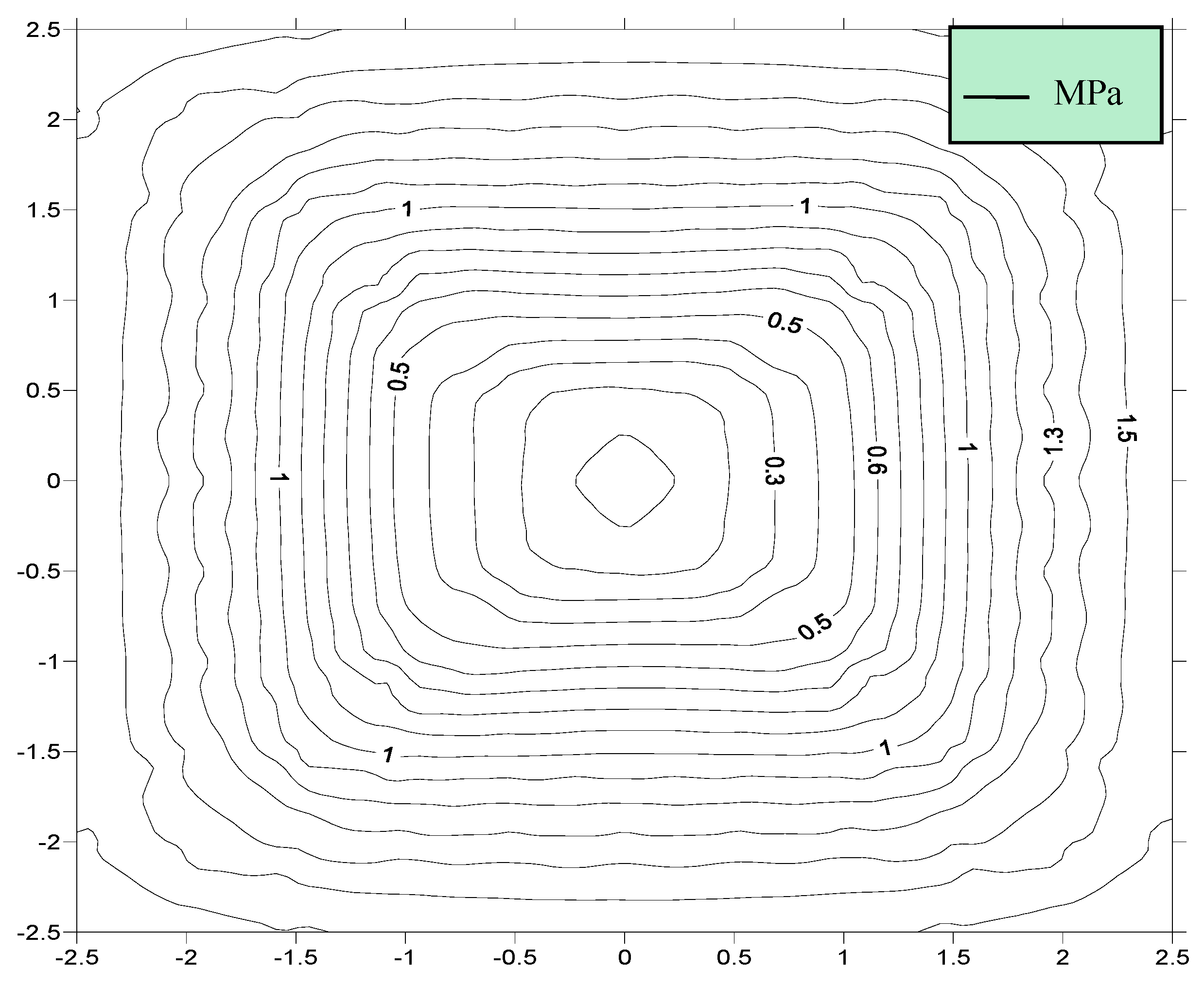
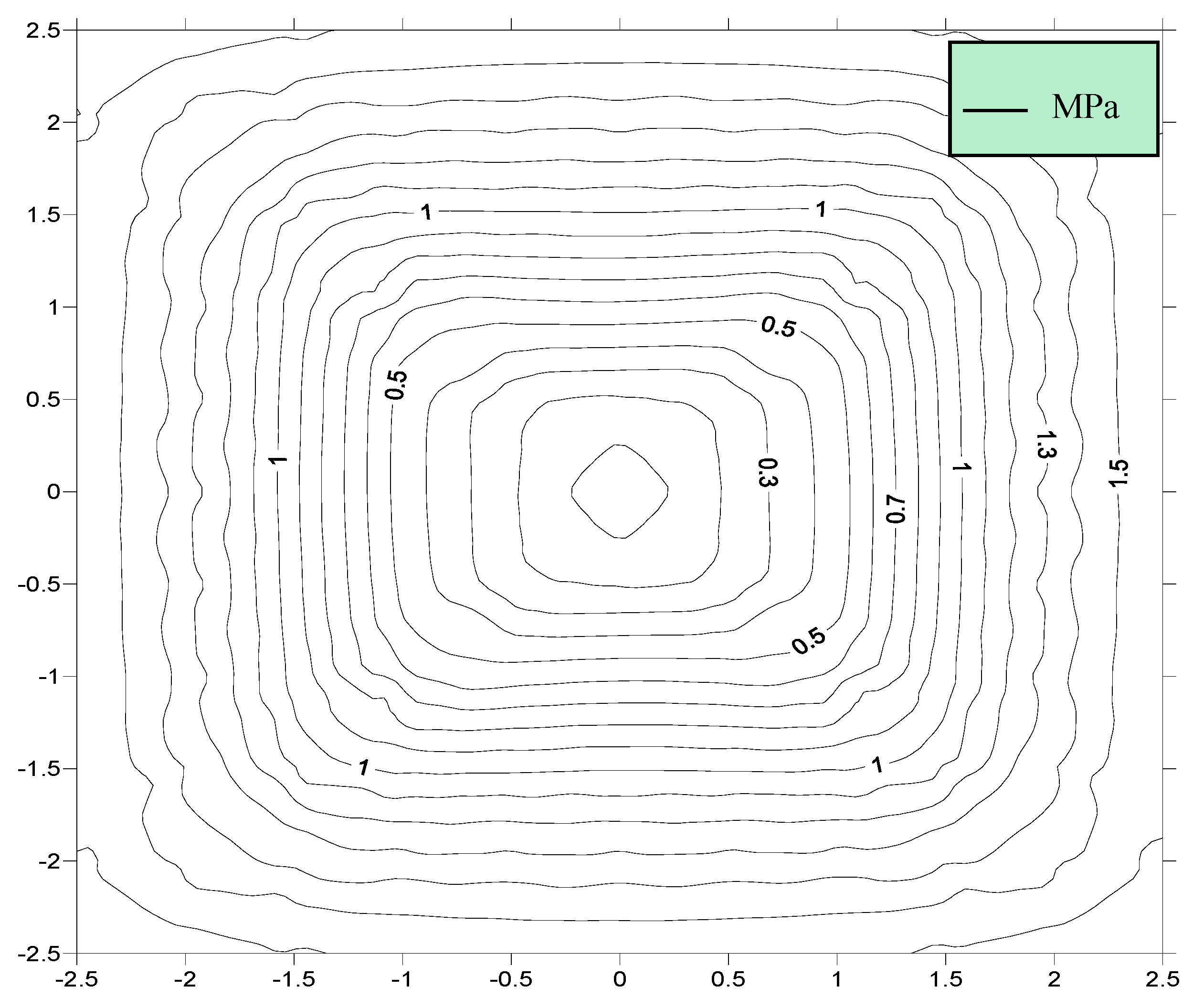

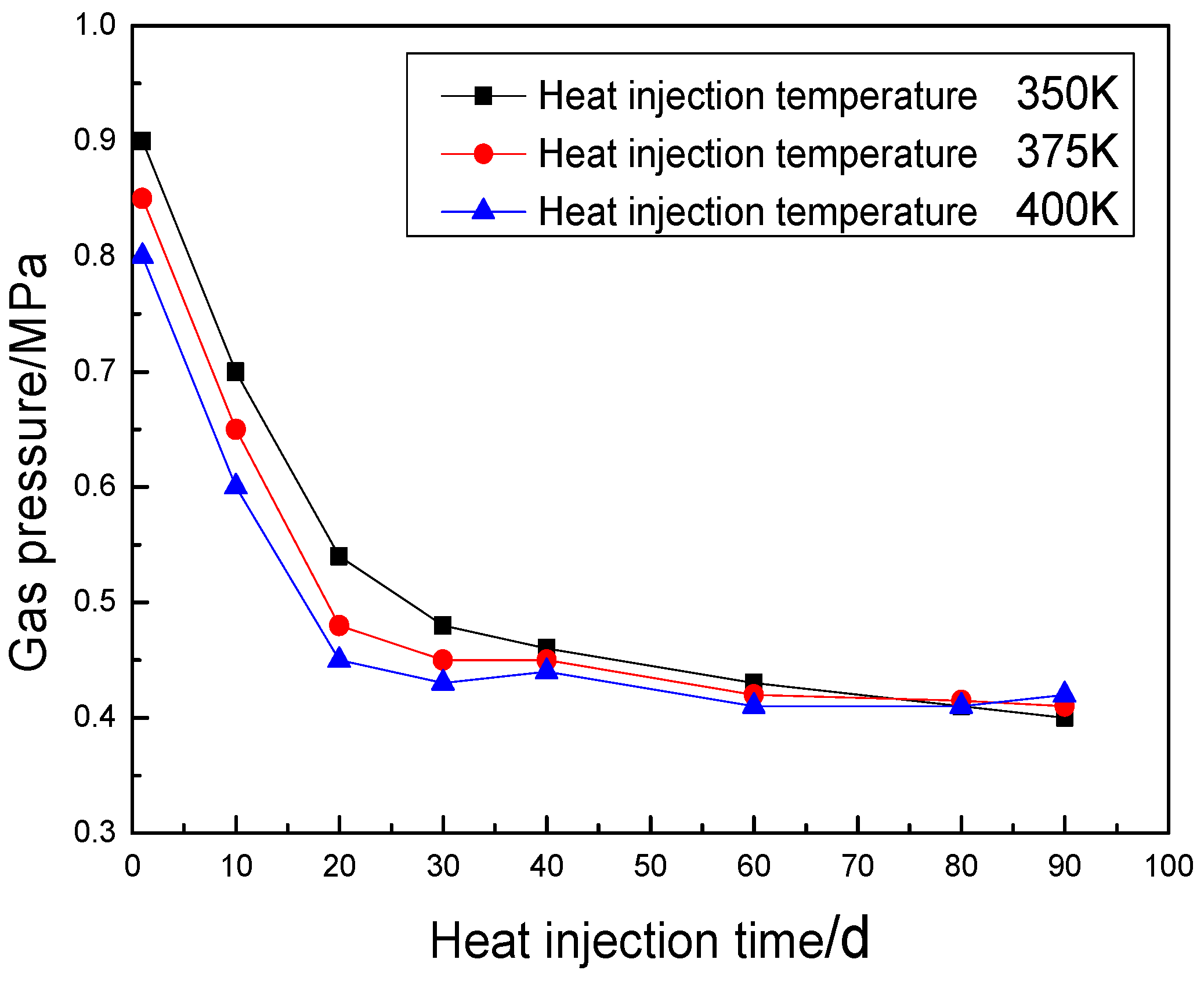
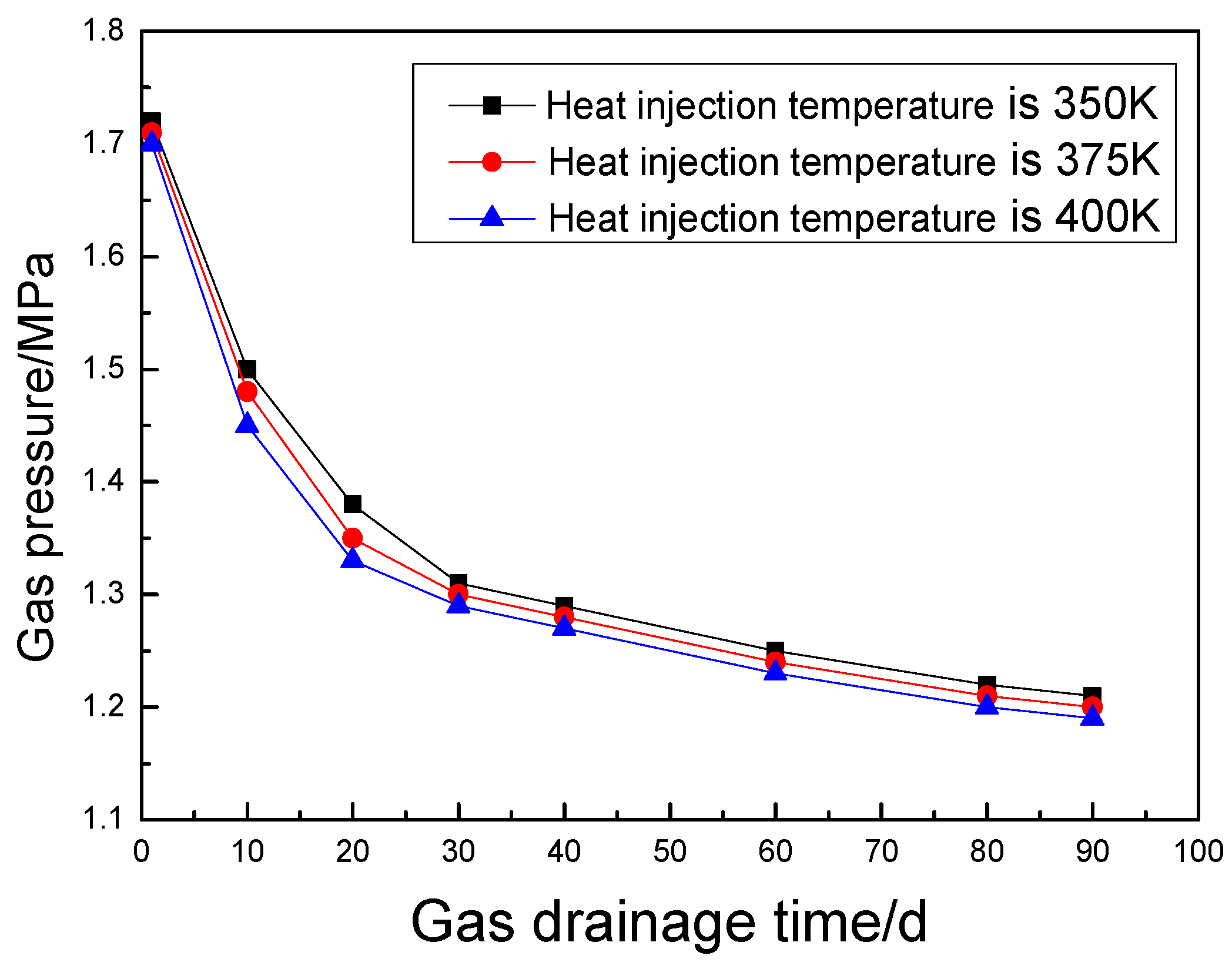
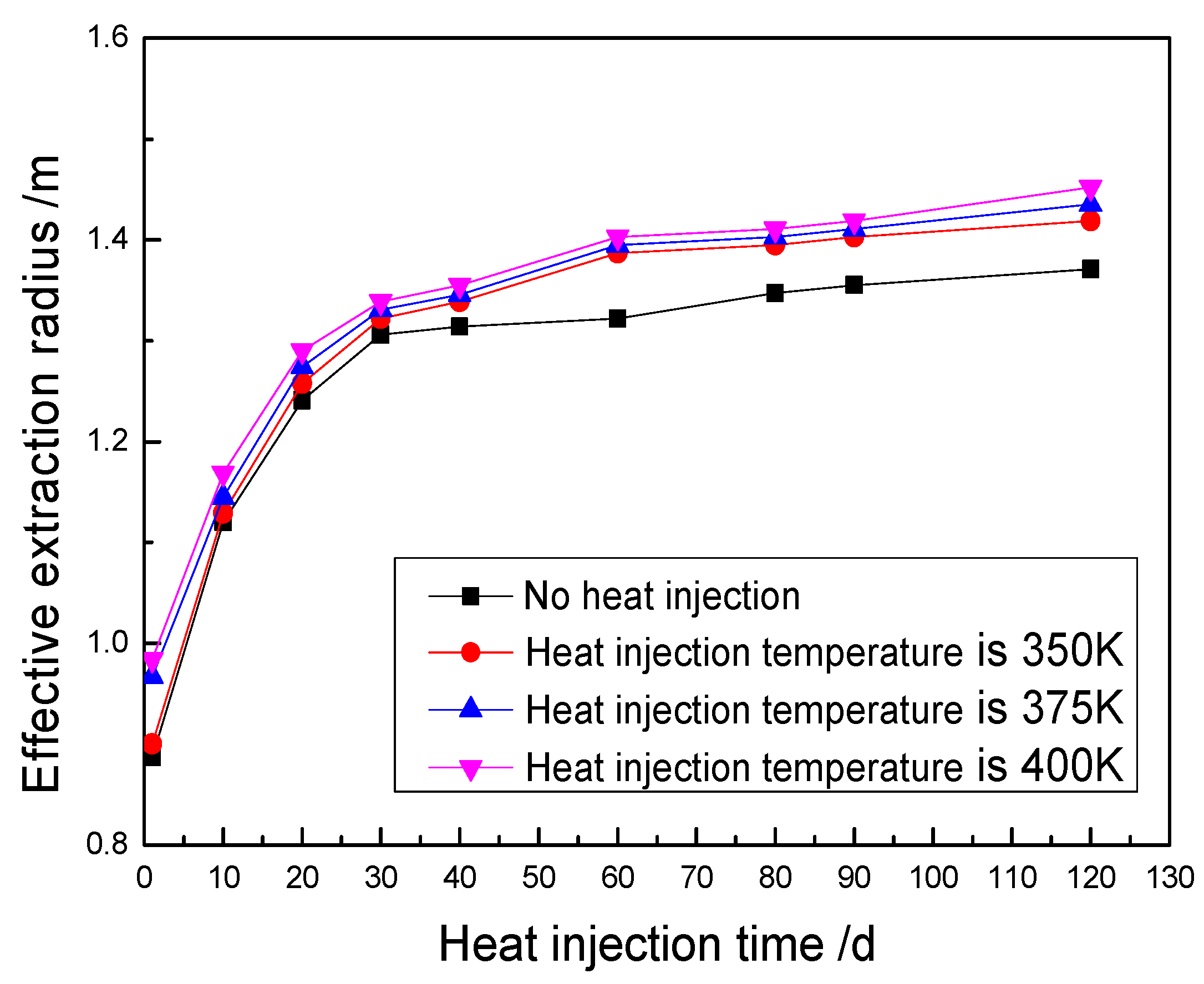

| Different temperature | Model 1:350 K |
| Model 2:375 K | |
| Model 3:400 K | |
| Different coefficient of thermal expansion | Model 1:1 × 10−7 K−1 |
| Model 2:5 × 10−7 K−1 | |
| Model 3:1 × 10−6 K−1 |
| Strata Formation Name | Thickness h /m | Elastic Modulus E /GPa | Poisson Ratio | Internal Cohesion /MPa | Internal Friction angle /(°) | Tensile Strength /MPa | Density /kg·m3 |
|---|---|---|---|---|---|---|---|
| roof | 8 | 5.89 | 0.16 | 3.2 | 40.9 | 3.7 | 2721 |
| Coal seam | 1.8 | 2.4 | 0.29 | 0.2 | 20 | 0.28 | 1450 |
| foundation | 12 | 5.89 | 0.16 | 3.2 | 40.9 | 3.7 | 2721 |
| Lengthvariable | 1 m = 3.281 feet |
| Gas production | 1 m3 = 1000 L = 6.29 bbl |
| Temperature | 1 K = 1 °C + 273.15 |
| Quality | 1 t = 1000 kg |
| Permeability | 1 m2 = 1.013 × 1015 md |
| Pressure | 1 MPa = 106 Pa |
© 2019 by the authors. Licensee MDPI, Basel, Switzerland. This article is an open access article distributed under the terms and conditions of the Creative Commons Attribution (CC BY) license (http://creativecommons.org/licenses/by/4.0/).
Share and Cite
Cheng, H.; Zhang, N.; Yang, Y.; Peng, W.; Chen, H. A Study on the Mechanical Mechanism of Injection Heat to Increase Production of Gas in Low-Permeability Coal Seam. Energies 2019, 12, 2332. https://doi.org/10.3390/en12122332
Cheng H, Zhang N, Yang Y, Peng W, Chen H. A Study on the Mechanical Mechanism of Injection Heat to Increase Production of Gas in Low-Permeability Coal Seam. Energies. 2019; 12(12):2332. https://doi.org/10.3390/en12122332
Chicago/Turabian StyleCheng, Hongmei, Ning Zhang, Yugui Yang, Weihong Peng, and Heng Chen. 2019. "A Study on the Mechanical Mechanism of Injection Heat to Increase Production of Gas in Low-Permeability Coal Seam" Energies 12, no. 12: 2332. https://doi.org/10.3390/en12122332
APA StyleCheng, H., Zhang, N., Yang, Y., Peng, W., & Chen, H. (2019). A Study on the Mechanical Mechanism of Injection Heat to Increase Production of Gas in Low-Permeability Coal Seam. Energies, 12(12), 2332. https://doi.org/10.3390/en12122332




